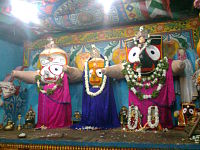- Nabakalevara
-
The term Nabakalevara ( Oriya:ନବ କଳେବର ),(Sanskrit:नवकलेवर) is derived from the Sanskrit words Naba or new and Kalevara or body, literally meaning New Body. It is an ancient ritual associated with Lord Jagannath of Puri performed every twelve years when the Idols of Lord Jagannath, Balabhadra, Subhadra and Sudarshan are replaced by a new set of Idols.
Contents
Timing of the Ceremony
A year which has two months(Adhika masa) of Ashadha as per the Hindu Calendar is auspicious for conducting the ceremony. This usually occurs every twelve to nineteen years.[1] The Idols are made from a special type of Neem wood known as Daru Bramha. Preparations for the ceremony start in the month of Chaitra.Last ceremony was done in the year 1996
Jirna Bera Parityaga
Oriya:(ଜୀର୍ଣବେର ପରିତ୍ୟାଗ),(Sanskrit:जीर्ण बेर परित्याग) Literally meaning leaving the old idol and consecration of new one.
Second verse of the second Chapter of Srimat Bhagavat Gita [2] mentions:
"...vāsāḿsi jīrṇāni yathā vihāya
navāni gṛhṇāti naro 'parāṇi
tathā śarīrāṇi vihāya jīrṇāny
anyāni saḿyāti navāni dehī..."As a person puts on new garments, giving up old ones, the soul similarly accepts new material bodies, giving up the old and useless ones.
The above philosophical view is applied to Shri Jagannath. According to different secret protocols followed from time immemorial in the temple,the provision is there for changing of the idol of deities.As the deities are made up of Neem tree basically,along with Musk, Sandalwood and many other rare combinations,they undergo change of Vigraha before the adhika ashaadha ends.Different agama shastra followed in other parts of India for Vishnu worship,such as Vaikhanasa also prescribe change of idol made up of wood under specific astrological combination.It is to be noted that the idols made of stone or metal need not be changed unless damaged,but the wooden idols are to be changed within specific gap of years and the supreme power must be installed from the old one to the new one,by secret rituals.
Locating the Sacred trees
No ordinary Neem tree can be used to make the Idols. Certain well defined criteria must be satisfied by the tree before it is labelled a Daru Bramha fit for idol making.[2] Locating the four holy trees requires divine intervention. As per long standing tradition the Priests of the Jagannath Temple (Puri) worship Maa Mangala at the Kakatpur Mangala Temple. It is said the Goddess appears to them in their dreams revealing the location of the holy trees.[3]
Ritual Procedures
After the sacred trees are located they are cut down after appropriate ritual observance. The logs are then transported by small carts pulled by devotees all the way till the temple at Puri.Starting at an auspicious hour with the fullest of secrecy the logs are carved into deities within the Temple premises. On the midnight of Adhika Ashadha krishna Chaturdashi the Tattva Padartha is transferred from the old deity to the new idols. After this the new idols are worshiped and the old idols buried in the sand,inside temple premises.
References
- ^ Details of Nabakalevara Ceremony
- ^ Interested readers are referred to this website for further details about the criteria [1]
- ^ Details of The Goddess at Kakatpur
Bramha or tattva padartha is a super natural thing.
Jagannath Worship Deities 
Temples India Puri · Gundicha Temple · Koraput · Nayagarh · Bhubaneswar · Kendrapara · Chandikhole · Baripada · Dharakote · Ranchi · Hyderabad · DelhiOther Festivals and
CeremoniesTexts Devotees Categories:- Festivals and ceremonies of Jagannath Cult
Wikimedia Foundation. 2010.
